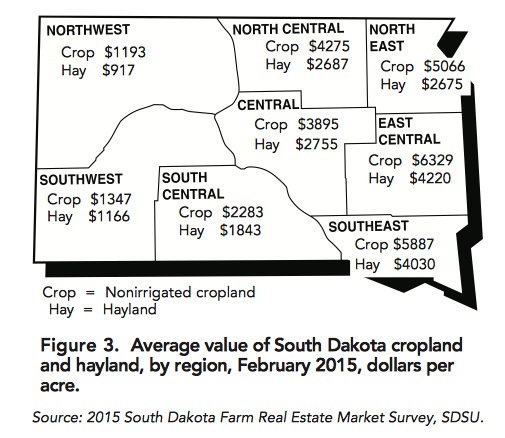SDSU Extension has issued its annual report on agricultural land values in South Dakota. As expected, lower crop prices checked the increase of land values in East River, while higher cattle prices contributed to a remarkable increase of land value West River.



In general, ag land between Brookings and Sioux Falls still draws seven times the sale price of ag land between Buffalo and Belle Fourche. The highest cropland values are in Minnehaha and Moody counties, where values ranged from $6,045 to $9,977 per acre. The more southerly portion of the I-29 corridor—Lincoln, Turner, Clay, and Union counties—were a close second, with cropland values ranging from $5,912 to $9,823 per acre.
To put that in perspective, a South Dakota farm family that hung onto great-great-grandpa’s 160-acre homestead would be holding onto land worth a bit more than $400,000 on the statewide average. Such a homestead around Chester or Canton would be worth just about $830,000. The owner of an average-sized farm (1,352 acres, a bit more than two full sections) near Flandreau could be sitting on $8.2 million to $13.5 million in land value.
Rental values present an interesting trend:


As interest rates have gone down, so has return on rental land. Through the 1990s, landlords were making and average of 7.4% of their land’s value in rent. Last year the return on renting ag land dropped to 2.9%. Put another way, at 1990s rents and land values, owners could recoup the full value of their land through rent in 14 years. At today’s rates, full recoup would take 35 years.
Given the projected prices for grain crops over the next few years, I expect land prices to drop some.
Nick, I’m nearly done with this blog but could you talk about the future of pulse crops and local foods?
What about the beef/rangeland side, Nick?
I would like to try pulse crops but the current system makes it very difficult to market them and to find information on how to plant, tend or harvest.
Direct to consumer local food producers who live near a bigger city will have a much easier time selling their produce than someone like me who lives in the sticks. I have a neighbor who worked for years in DC, first as a staffer for Tom Daschle then as a political consultant. She moved back to the family farm a few years back and is marketing a portion of the beef she raises online. I wish her well.
http://www.haiwickheritageranch.com/
Larry,
Why are you nearly done with this blog?
Nick,
The what is the appeal to pulse crops? Less chemical input? Organic?
Given high beef prices I expect rangeland rates to hold steady or increase slightly. Some marginal farm land, particularly West River may be converted back to rangeland.
Interestingly, visiting with the store manager and the shop manager of my local Titan Machinery store, I’m told stores further east are doing poorer than stores further west. They attribute this to low grain prices, high cattle prices, and the historic greater impact of cattle on the ag economy the farther west you go. Cowboys have money to spend right now, dirt farmers don’t.
I see this from Montana Dept of Ag regarding Pulse Crops and would love to see more opportunities for our grain farmers
http://agr.mt.gov/agr/Producer/PulseCrops/ and love Hummus made from chickpeas and I’m not talking what’s marketed as Hummus at Walmart. lol
So called pulse crops are legumes and fix nitrogen, potentially lowering costs. Also planting them is a strategy the old timers preached, don’t put all your eggs in one basket. When the price is down on one crop it might be up on another and slightly different growing patterns might favor one crop over another in any given year.
Titan Machinery closed down one implement up in Bowdle with little notice earlier this year due to the market. I don’t know where else but it’s too bad for a small town like Bowdle and the local farmers that need parts and service.
http://www.greatfallstribune.com/story/news/local/2015/06/08/farmers-adapt-union-recognizes-climate-change-effects/28692205/
As pressure grows to reduce farm pollution of waterways, so-called pulse crops will probably grow in popularity as a non-polluting fertilizer. Isn’t buckwheat a popular winter cover crop because it is an effective fertilizer too?
In Washington state on the Skagit River flat north of Seattle, tulips are raised extensively. The tulip bulbs are harvested in late April, then peas are planted. It’s a perfect symbiosis because they feed each other. (The pea plant closed about 20 years ago, so that crop pattern no longer occurs.)
The older I becumpt the more I only have interest in farmers whom grow things I want to eat: vegetables, fruits, nuts, fish, and a little hormone & antibiotic free meat. The rest is apparently junk that is unhood for you.
http://www.forksoverknives.com/synopsis/
Lar, do you see how pulse crops just don’t work in the real world? Stop being a child and stomping your leather Jesus sandals in the dirt. Grow up man, you’re nearly and old man these days.
You boys ain’t got nuthin’ on those land prices in MN. There was one old farmer that held out and finally sold his last remaining 28 acres right in the middle of Rochester MN at 1.85 million. The ol’ boy finally did it after years of business men buzzin’ him all the time about gettin’ it sold. I doubt the small cow herd came with it though and I actually missing seeing those cows. :)